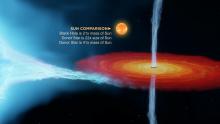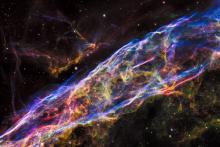Listen to today's episode of StarDate on the web the same day it airs in high-quality streaming audio without any extra ads or announcements. Choose a $8 one-month pass, or listen every day for a year for just $30.
You are here
Sadr
The night sky plays tricks on us. Objects that look like they’re right on top of each other can be separated by thousands of light-years.
An example is the star Sadr. It connects the body and wings of Cygnus, the swan, which soars high overhead on August nights.
Sadr is a supergiant. It’s at least a dozen times the mass of the Sun, 150 times wider than the Sun, and more than 30,000 times brighter. It’s only about 12 million years old — a tiny fraction of the age of the Sun. Yet it’s already nearing the end of its life. Before long, it will explode as a supernova.
A telescope reveals wisps of red around Sadr — clouds of glowing gas. And photographs reveal even more of the clouds. In fact, it looks like Sadr is enveloped by them. Yet they’re not even close. The clouds are about 3,000 light-years farther than Sadr.
The clouds glow because they’re “energized” by the radiation from bright young stars that are associated with them. And the clouds are huge — they span more than a hundred light-years. Some of their gas and dust will collapse to give birth to more stars.
In time, Sadr will produce its own cloud. When it explodes, it’ll create an expanding shell of gas and dust. The shell will be visible for thousands of years. To future skywatchers, it may look like it’s just part of the larger complex of clouds behind it — another illusion in the night sky.
Tomorrow: bright companions at dawn.
Script by Damond Benningfield






